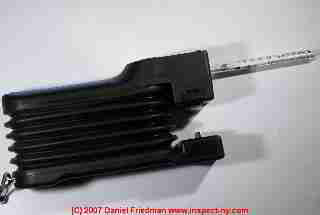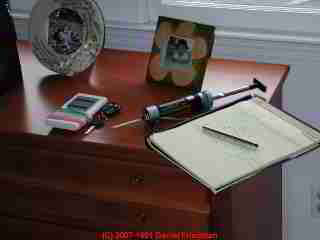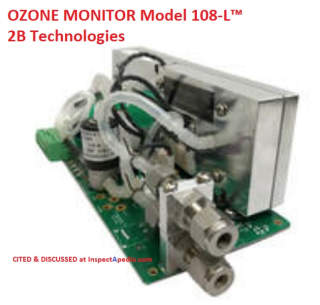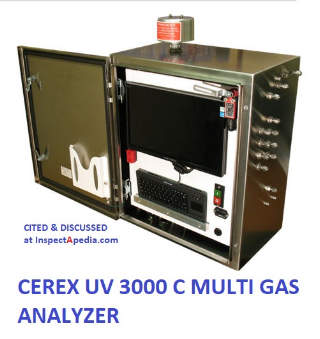 Test for Ozone
Test for Ozone
in Buildings: how, when, where, why
- POST a QUESTION or COMMENT about Tests for Ozone in Indoor Air using gas pumps and colorimetric gas detection tubes, badges, or test equipment
Ozone detection & testing methods:
This article discusses methods for ozone testing in indoor air to determine the presence of ozone & to assess the level of exposure to ozone gas.
We compare different ozone test approaches using pumps and sampling tubes, badges, or electronic equipment. Our photographs on this page illustrate different ozone test tools & equipment.
InspectAPedia tolerates no conflicts of interest. We have no relationship with advertisers, products, or services discussed at this website.
- Daniel Friedman, Publisher/Editor/Author - See WHO ARE WE?
How to Test for Ozone Contamination, Ozone Damage & for for Related Ozone-Related Outgassing Hazards Due to Oxidized Materials
 "Ozone is a highly toxic gas but even highly toxic substances can be encountered safely.
"Ozone is a highly toxic gas but even highly toxic substances can be encountered safely.
The main concern with this material is that concentrations to which people are exposed should not average more than 0.1 ppm over an 8-hr day, and should not exceed that value by more than a factor of 2 or 3 during the exposure." [1]
Article Contents
- TESTS for OZONE in INDOOR AIR
- TEST / MONITOR for OZONE EXPOSURE: BADGES
- TEST / MONITOR OZONE EXPOSURE: DETECTION EQUIPMENT
Because ozone is highly volatile and is not likely to remain present in a building unless an ozone generating device is operating, we do not normally include ozone testing in building IAQ screening measurements for gases.
In exceptional circumstances we may test an indoor environment for ozone levels. Normally we do not, as this gas is so volatile and reactive that it would not be expected to remain in an environment.
However, the byproducts of using ozone gas at high concentrations and durations indoors (for example during a "mold remediation using ozone" may oxidize and cause outgassing from other building products.
Tests for Ozone in Indoor Air using gas pumps and colorimetric gas detection tubes
When circumstances warrant, I would screen for a variety of common outgassing products such as formaldehyde, benzene, formic acid and other acid gases, toluene and related gases. Our tests for these gases are described in our clients' sampling plan.
I also may apply one or more of the three sets of multiple-gas hazard screen systems provided by Drager for the fire investigator profession.
At high or low levels (various test sensitivities are available) produced by popular indoor air "purifiers" and by commercial treatments for odors is a highly-reactive oxidizing gas which is dangerous to lung tissue itself.
Ozone gas may react with other building materials (as an oxidant) to produce secondary outgassing products which are also irritants or potentially unsafe.
Ozone is highly reactive and volatile and may not be present in a building long after it was applied. Choice of use or omit this screen depends on the circumstances of the particular investigation.
As a regular practice I include this screen for ozone where such equipment is in use (to detect dangerous current levels) or where commercial equipment has been very recently in use. Sensidyne™ #182SB 2.5-100 ppm / #182U 0.025 - 3.0 ppm.
Benzene 0.5/a: If there is a particular concern for Benzene I perform a test for this substance. I select a sampling tube which is not Benzene specific in order to also screen for other aromatic hydrocarbons including toluene, xylene (more likely to be in carpet out gassing than benzene) and ethel benzene.
Our test sensitivity is 0.4 to 10 ppm (40 to 2 strokes). +/30%.
Formaldehyde 0.2/a: because this gas is produced at virtually all house fires and because it is a well-known respiratory and eye irritant produced by many building materials even without combustion effects, if there are owner/occupant complaints, this test may be performed using the Gastec pump and tubes produced by Sensidyne or by the Draeger accuro pump and their tubes.
Sensitivity 0.2 to 2.5 / 0.5 to 5 ppm at 10 / 20 strokes. Alternative: Sensidyne ™ Gastec™ 91/L 0.1-40.0 ppm
Formic acid 1/a: because this gas screen addresses acid gases which can be expected to be produced by fire, heat, or oxidation (such as from ozone treatment) in commercial and residential properties it is an important screen for this topic. Our test sensitivity 1 to 15 ppm, 20 strokes.
Toluene 5/b: because this is one of the most sensitive gas screens available to address gases which can be expected to be produced by fire, heat, or oxidation (such as from ozone treatment) in commercial and residential properties it is an important screen for this application.
Toluol is a common contaminant produced by oxidized or burning carpets. Our test sensitivity 5-300 ppm
Testing or monitoring for ozone exposure using badges
Several companies provide low-cost badge systems for monitoring the exposure of workers (or others) to ozone gas.
In our OPINION badges for ozone monitoring, while entirely suitable for an industrial environment, are unlikely to be useful for consumers or building owners who are concerned with the effects of short-term use of ozone in buildings or other enclosed spaces, such as services marketed for building deodorizing or mold "remediation".
OPINION: It might be possible to use an ozone detection badge to examine the actual ozone level in an enclosed space where an ozone generator or ozone "air purifier" is in use, but we warn that drawing any conclusions about the actual ozone exposure of building occupants in such cases will be confounded by difficulties in constructing and maintaining a controlled environment.
Watch out: ozone detection badges may have a limited shelf life and may require storage in a refrigerator prior to use.
Ozone exposure monitoring badges range in price from about $10. U.S. to $130. U.S.
- [15] Ozone Solutions, Inc., 451 Black Forest Rd., Hull, IA 51239 USA, Tel: 888 892-0303
Testing or monitoring for ozone exposure using ozone monitoring or ozone detection equipment
 Shown here: 2B Technologies portable ozone level monitor, Model 108-L Ozone Monitor™ cited & described below.
Shown here: 2B Technologies portable ozone level monitor, Model 108-L Ozone Monitor™ cited & described below.
Several companies offer electronic instruments used for monitoring ozone gases in air or water as well as equipment that may be used to monitor for related gases or contaminants.
Typically these machines measure the level of ozone in parts per billion in air (ppb of ozone in air).
2B's ozone monitors make use of UV-based ozone detection to monitor ozone levels at various concentrations in air, taking advantage of the fact that ozone molecules absorb light at in a narrow band around 254nm coincident with a low-pressure mercury lamp or light source.
A cogent explanation of theory and practice in ozone detection using this method is provided by the company in both online videos and in the 2B Technologies ozone monitor operating manual(s) cited below.
Handheld ozone gas level monitors range in price from around $300. U.S. to $3000. and of course vary in intended use.
- 2B Technologies, 2100 Central Avenue Suite 105, Boulder, Colorado 80301 USA, Website: https://twobtech.com/ Tel: (303) 273-0559, produces Ozone detection equipment, Email: sales@twobtech.com
The company provides about twenty different models and version of air pollution measurement equipment (as of April 2020-Ed.).
[question on ozone detection in human urine, pending 12/19/11 - ed.]
OZONE MOINTOR MODEL 108-L OPERATION MANUAL [PDF] retrieved 2020/04/22 original source: https://twobtech.com/docs/manuals/model_108-L_revD-6.pdf
This ozone monitor has a limit of detection of 3.0 ppb of ozone and is accurate to 2% of the reading.
Website excerpt:
The Model 108-L provides accurate measurements of ozone in air over a wide dynamic range extending from a few parts-per-billion by volume (ppb) to an upper limit of 100 parts-per-million (ppm) based on the well-established technique of absorption of ultraviolet light at 254 nm.
The Model 108-L is designed for integration in the user’s ozone system and makes use of the ozone system’s pump to supply the air sample.
The Model 108-L Ozone Monitor is lightweight (2.0 lb, 0.89 kg), has a low power consumption (~2 watt) relative to conventional instruments, and requires minimal maintenance, making it well suited for monitoring of ambient ozone and monitoring/control of ozone in industrial settings. The Model 108-L is ideal for the following applications:
Replacement of HMOS and Electrochemical sensors in an existing ozone system
Monitoring ozone exposure of individuals in the workplace
Monitoring and control of ozone in industrial settings
Incorporation into ozone disinfection systems
Long-term monitoring at remote locations where power is highly limited

- Cerex Monitoring Solutions, LLC., 1816 Briarwood Industrial Ct., Suite D, Atlanta, Georgia 30329
Tel: 678-570-6662 Email: sales@cerexms.com. Cerex has offices in many countries worldwide. Website: http://www.cerexms.com
Cerex provides various air quality and pollutant monitoring equipment including the Cerex UV2000 Series of analyzers cited here.
CEREX UV3000C MULTI-GAS ANALYZER BROCHURE [PDF] retrieved 2020/04/22 original source: http://cerexms.com/wp-content/uploads/2013/06/Brochure_Cerex_UV3000C.pdf
This analyzer detects 17 different gases including (some examples, with detection limits using a with 8.5 meter cell.)
Ammonia 24 ppb
Formaldehyde 376 ppb
Mercury 12 ppb
Ozone 235 ppb
Sulfur Dioxide 38 ppb
Website excerpt:
The Cerex UV 3000C is a fixed mount multi-gas analyzer with internal sample cell. Available with an integrated twelve port multiplexer, the UV 3000C offers sequential zone monitoring of up to ten locations for leak detection, process monitoring or indoor air quality monitoring.
Two ports are generally reserved for operator specified quality assurance audits. Continuous parallel sample acquisition reduces latency and for many applications the sample acquisition cycle is one minute in duration.
Unlike competing technologies, UVDOAS is unaffected by humidity, cannot be poisoned, and offers detection limits specified by the operator for the application.
Capable of very low ppb level detection of common refinery gases, solvents, and combustion gases, the UV 3000C represents added value over competing technology in terms of both cost and performance.
...
Continue reading at OZONE TOXICITY or select a topic from the closely-related articles below, or see the complete ARTICLE INDEX.
Or see these
Recommended Articles
Suggested citation for this web page
OZONE TESTS at InspectApedia.com - online encyclopedia of building & environmental inspection, testing, diagnosis, repair, & problem prevention advice.
Or see this
INDEX to RELATED ARTICLES: ARTICLE INDEX to BUILDING ODOR DIAGNOSIS & CURE
Or use the SEARCH BOX found below to Ask a Question or Search InspectApedia
Ask a Question or Search InspectApedia
Try the search box just below, or if you prefer, post a question or comment in the Comments box below and we will respond promptly.
Search the InspectApedia website
Note: appearance of your Comment below may be delayed: if your comment contains an image, photograph, web link, or text that looks to the software as if it might be a web link, your posting will appear after it has been approved by a moderator. Apologies for the delay.
Only one image can be added per comment but you can post as many comments, and therefore images, as you like.
You will not receive a notification when a response to your question has been posted.
Please bookmark this page to make it easy for you to check back for our response.
IF above you see "Comment Form is loading comments..." then COMMENT BOX - countable.ca / bawkbox.com IS NOT WORKING.
In any case you are welcome to send an email directly to us at InspectApedia.com at editor@inspectApedia.com
We'll reply to you directly. Please help us help you by noting, in your email, the URL of the InspectApedia page where you wanted to comment.
Citations & References
In addition to any citations in the article above, a full list is available on request.
- [13] 2B Technologies, 2100 Central Avenue Suite 105, Boulder, Colorado 80301 Tel: (303) 273-0559, produces Ozone detection equipment
- [2] Ozone and other contaminants discussed, New York State Department of Environmental Conservation,
- [3] Indoor air, https://www.health.ny.gov/environmental/air_quality/#indoor_air New York State Department of Health
- [5] Foarde, Karin K. "Development of a method for measuring single-pass bioaerosol removal efficiencies of a room air cleaner." Aerosol Science and Technology 30, no. 2 (1999): 223-234.
- Foarde, Karin K. "Methodology to perform clean air delivery rate type determinations with microbiological aerosols." Aerosol science and technology 30, no. 2 (1999): 235-245., page 235 Karin K. Foarde, Eric A. Myers, James T. Hanley, David S. Ensor, and Peter F. Roessler
- [6]Ozone is not a substitute for mold removal and its reaction with building materials, but applied by an expert may help deodorize, a cleaning article by Jim Holland - http://www.icsmag.com/CDA/ArticleInformation/features/BNP__Features__Item/0,3035,118663,00.html
- [7] Ozone as an oxidant, a few references from the Canadian Government
- Bogaty, H., Campbell K. S., and Appel, W. D. (1952). The oxidation of cellulose by ozone in small concentrations. Text. Res. J. 22: 81-83.
- Bradley, C. E., and Haagen-Smit, A. J. (1951). The application of rubber in the quantitative determination of ozone. Rubber Chem. Technol. 24: 750-755.
- Cass, G. R., Nazaroff, W. W., Tiller, C., and Whitmore, P. M. (1991). Protection of works of art from damage due to atmospheric ozone. Atmospheric Environment, 25A( 2): 441-451.
- Druzik, J. R. (1985). Ozone: The Intractable Problem. We stern Association for Art Conservation newsletter. (vol.7, no. 3)
benefits-of-ozone-laundry/ozone-laundry-faq/
The aim of this paper is to analyze why ozone can be medically useful when it dissolves in blood or in other biological fluids. In reviewing a number of clinical studies performed in Peripheral Arterial Diseases (PAD) during the last decades, it has been possible to confirm the long-held view that the inverted U-shaped curve, typical of the hormesis concept, is suitable to represent the therapeutic activity exerted by the so-called ozonated autohemotherapy. The quantitative and qualitative aspects of human blood ozonation have been also critically reviewed in regard to the biological, therapeutic and safety of ozone. It is hoped that this gas, although toxic for the pulmonary system during prolonged inhalation, will be soon recognized as a useful agent in oxidative-stress related diseases, joining other medical gases recently thought to be of therapeutic importance. Finally, the elucidation of the mechanisms of action of ozone as well as the obtained results in PAD may encourage clinical scientists to evaluate ozone therapy in vascular diseases in comparison to the current therapies.
Sampling for gases in air such as VOC's, MVOC's, toxic chemicals, and combustion products.
Unfortunately no single test or tool can detect all possible building contaminants. We use methods and equipment which can test for common contaminants. If the identity of a specific contaminant is known in advance we can also test for a very large number of specific contaminant gases in buildings.
We use gas sampling equipment provided by the two most reliable companies in the world, draeger-safety.com/ST/internet/US/en/Products/Detection/Drager-Tubes/Pumps/accuro/pd_accuro.jsp Draeger-Safety's detector-tubes and Drager accuro bellows pump, the Gastec cylinder pump and detector-tube system produced by Gastec or sensidyne.com/Tube/TubesProduct.htm - Sensidyne, and we also use Sensidyne's sensidyne.com/GIL/gilMain.htm - Gilian air pump. For broad screening for combustibles and a number of other toxic gases and for leak tracing we also use Amprobe's Tif8850. All of these instruments, their applications, and sensitivities (minimum detectable limits) for specific gases are described in our /sickhouse/Gas_Exposure_Testing.php Gas Sampling Plan online document.
CONTINUE READING or RECOMMENDED ARTICLES.
- Carson, Dunlop & Associates Ltd., 120 Carlton Street Suite 407, Toronto ON M5A 4K2. Tel: (416) 964-9415 1-800-268-7070 Email: info@carsondunlop.com. Alan Carson is a past president of ASHI, the American Society of Home Inspectors.
Thanks to Alan Carson and Bob Dunlop, for permission for InspectAPedia to use text excerpts from The HOME REFERENCE BOOK - the Encyclopedia of Homes and to use illustrations from The ILLUSTRATED HOME .
Carson Dunlop Associates provides extensive home inspection education and report writing material. In gratitude we provide links to tsome Carson Dunlop Associates products and services.

